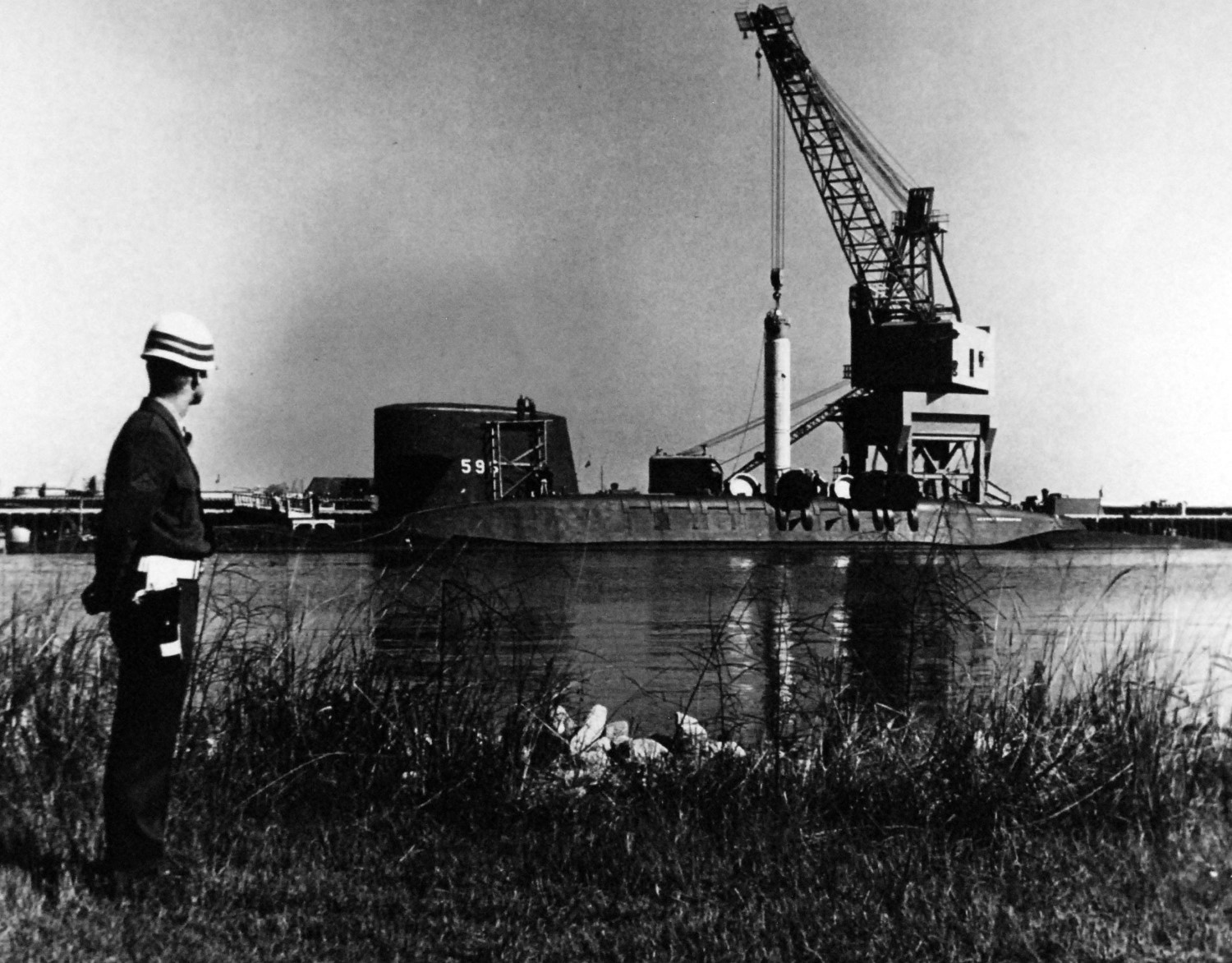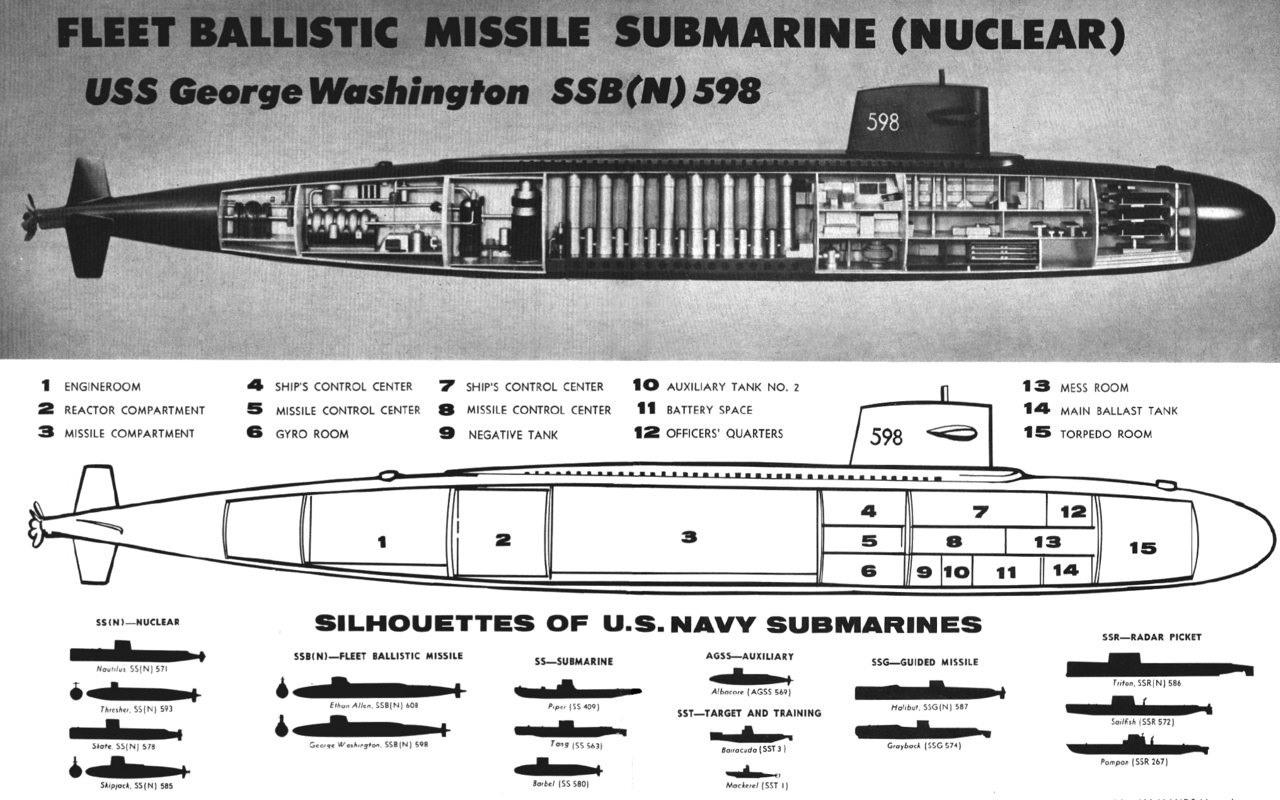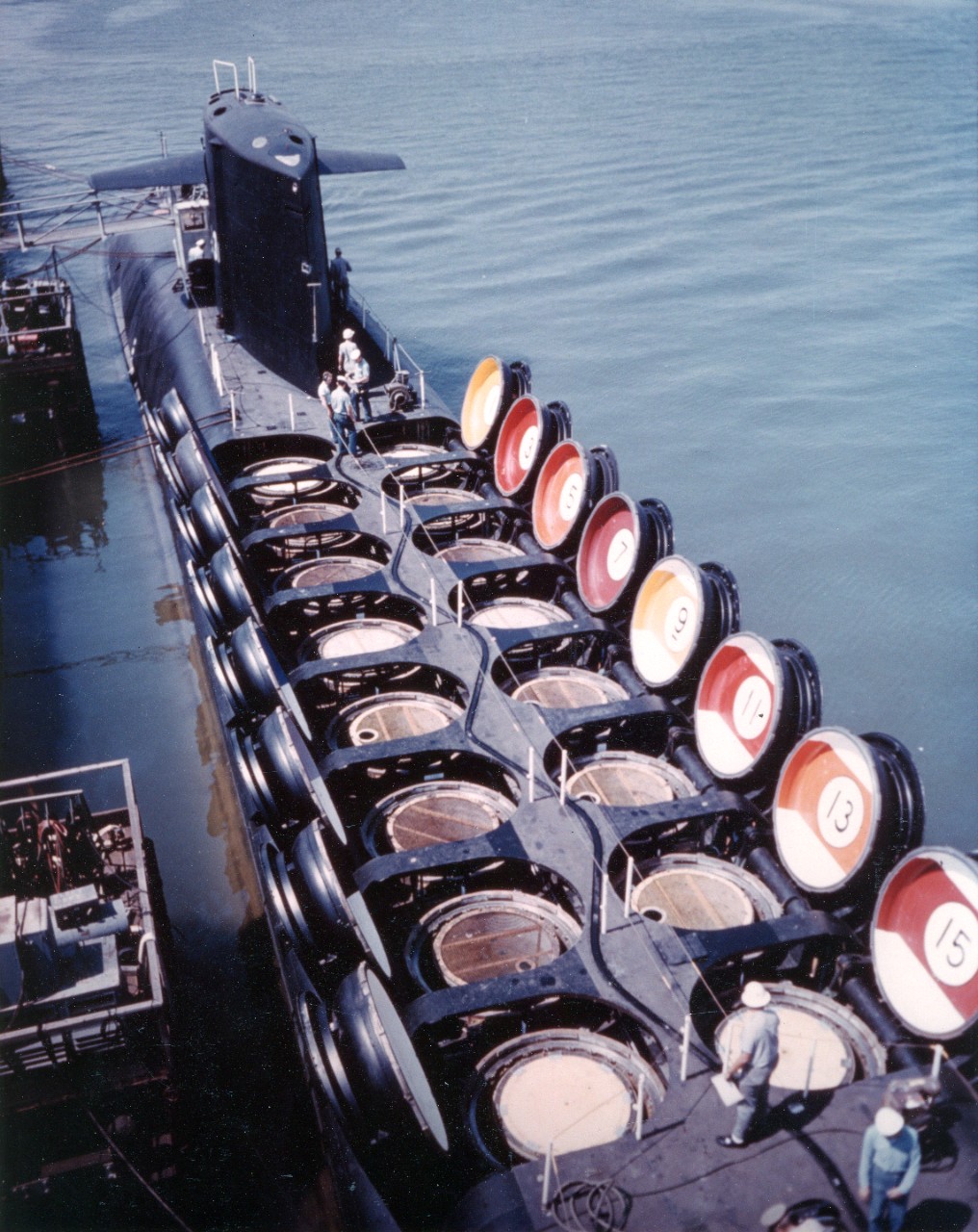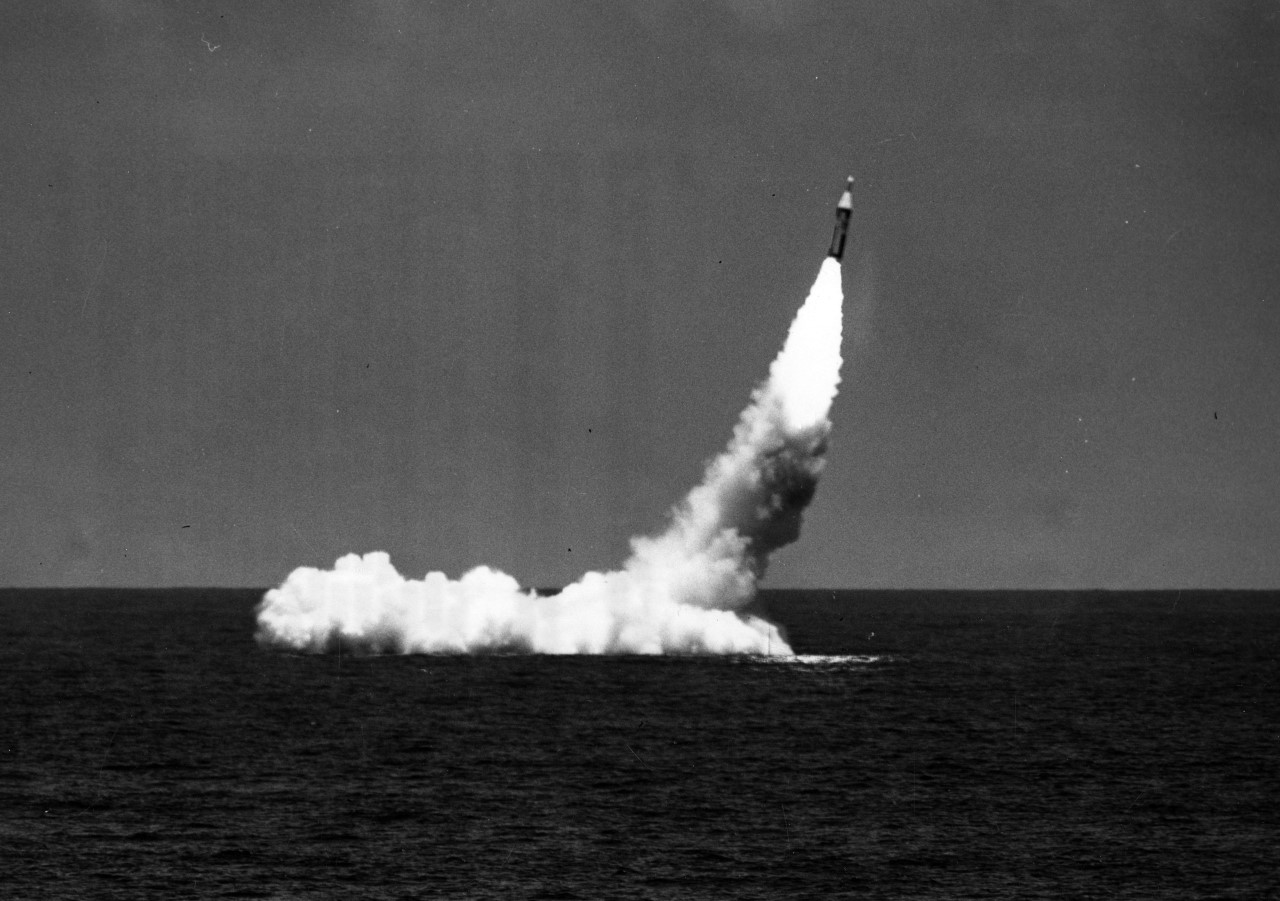On November 15th, 1960, USS George Washington cast off for the first patrol by an American ballistic missile submarine. Both the submarine and the missile she carried, known as Polaris, had existed only on paper a mere four years previously, when the Navy was given permission to develop its own ballistic missile instead of participating in the Army's Jupiter program. This incredible achievement, accomplished by the Navy's Special Projects Office under Admiral William Raborn, had involved overcoming numerous technical problems in both the submarine and the missile, all at the same time, producing what was known as the Fleet Ballistic Missile (FBM).

George Washington taking on missiles before her first patrol
George Washington herself had an interesting history. The Navy's ship designers had begun work on SSBNs while Jupiter was still the primary focus, with the missiles to be incorporated into the sail. Polaris, on the other hand, was short enough to fit into the hull, and each submarine could carry a lot more missiles. The big question was how many, and opinions varied widely, with submarine operators preferring as few as possible (four still sounded good to them, maybe 8 at the outside) and budget analysts wanting as many as they could (32 sounds like a nice number). Eventually, both groups compromised on 16, in two rows aft of the sail, a number designers believed provided the best tradeoff between firepower and the structural demands imposed by 6' cuts in the pressure hull. This configuration also put the missiles squarely at the submarine's center of gravity and reduced any trim problems that might arise from firing a missile, and gave a good path for the beams of light used to align the missile's guidance systems.

Once this decision was made, work began on a design, known as SCB 180, which would be broadly comparable to the contemporary Permit class SSNs. However, when the program was accelerated in late 1957, it became obvious that the first boat of this design couldn't possibly enter service before 1961, so alternate measures had to be taken. The first batch of SSBNs would instead be based on the earlier Skipjack class SSNs, the first of which had already been laid down. The plans were essentially sliced in half, and a missile compartment based on the one designed for SCB 180 was placed in the middle.1 The new submarine had the highest priority, and it appears that the submarine Scorpion, laid down in November, was actually cut in half and another submarine of that name laid down to take its place the following August.2 Four more boats of the same type were ordered as new-builds, although material from at least one other Skipjack was diverted to support the building program. George Washington was launched in June 1959 and commissioned on December 30th of that year, just shy of two years after she was ordered.

Sam Rayburn shows her missile hatches, with the "Billiard Ball" livery
Each of the 16 missile tubes was a technical marvel in its own right, capable of supporting the Polaris during a cruise, and then firing it from underwater. The heavy steel tube had within it a set of buffers that would hold the missile precisely in most cases, but would give it some flexibility if the submarine was subjected to depth-charge attack. The initial plan for Jupiter had been to fuel the missile below-decks and then use an elevator to raise it for launch while on the surface, much as the Soviets had done on their first ballistic-missile boats. Launch within the tube was impossible, as the missile's exhaust would be trapped with nowhere to go. But the elevators proved difficult to design, and raising the missile with compressed air was picked as an alternative. This raised serious issues with stopping the missile at the top, but the designers realized they could avoid this by just lighting the missile while it was rising. This approach was carried over to Polaris, where tests showed that it would also work underwater, and that the fear of the missile tipping over too far and messing up the guidance was largely unfounded.

The first Polaris test from George Washington
The launch procedure was reasonably straightforward. The submarine would be at a depth of maybe 125', moving as slowly as possible, and maybe even backing slightly. The tube would be pressurized to match the water outside, and the door at the top opened, leaving the missile covered by only a thin diaphragm. Then the high-pressure air would be injected at the bottom, pushing the missile through the diaphragm and out of the submarine. Several seconds later, when it was well clear of the sub, the motor would ignite, blasting it through the surface.3 A TV camera and powerful lights were fitted to the back of the sail to allow the crew to monitor the launches, which would generally be staggered by a minute or so, presumably to allow the disturbances caused by the previous launch to clear. Tests of the underwater launch system had begun in 1958, many using redwood logs, but the first full-scale test of the missile hadn't happened until July 20th, 1960, when George Washington fired two unarmed missiles. Both reached their targets successfully, and the Captain sent a message to President Eisenhower: POLARIS - FROM OUT OF THE DEEP TO TARGET. PERFECT. Next time, we'll take a closer look at these missiles, and how they worked.
1 Admiral Rickover was a strong proponent of fitting any SSBN with twin reactors and propellers for redundancy, and he was horrified at this plan. Burke solved this problem by ordering Raborn to cut him out of the discussion, a rare defeat for the politically astute Rickover. Ultimately, all US SSBNs had a single screw. ⇑
2 This is a surprisingly confusing issue. Most sources give the "cut in half on the slipway" version, but Norman Polmar instead claims that no cutting was done and material from Scorpion was diverted to George Washington. A careful study of the dates involved does not support this. George Washington is listed as having been laid down on 1 November 1957 by most sources (except its Wiki article, which says 1958) and yet the order wasn't placed until 31 December 1957. The hull numbers point to an order date after mid-November, when the previous ship in the submarine series, Tullibee, was ordered. I am more than a little surprised that the hull number was changed, but I suspect that little work had been done on the Scorpion in the two months between laying down and the new order, particularly as the Navy would have had to work with the builder, Electric Boat, ahead of time. The bigger time saving was probably in making use of material already ordered for the task. ⇑
3 The system was capable of launching a missile while on the surface, although this was definitely not standard procedure. ⇑

Comments
Is your footnote #1 in the wrong spot? I don't see why cutting the hull in half would lead to a single-screw design.
Because it meant that Washington would have the Skipjack propulsion system. Two screws would have required a clean-sheet design.
How did this work?
I talk more about guidance later on. The short version is that light was used to transfer the alignment of the ship's inertial navigation platform to the weapons. The long version involves a book or three.
So basically a lamp + photo cell to initialize the guidance system?
It was more complicated than that. They had a rail-mounted cart that would look through a window in the tube and missile to see a porro prism (whatever that is) on the guidance system's outer gimbal. This let them align the platform and get a precise value for the difference between the INS vertical and the missile vertical. Without that, the missile doesn't know exactly where it is, and can't hit the target.
Wikipedia sez on the subject of porro prisms that they are triangular doubly-reflective prisms, often used in binoculars.
What volume of air, and under what pressure, was required to lift the missle out of the tube and far away from the vessel so that the ignition could be started?
It seems like it would take a high volume of air delivered in a short time with the pressure not too high lest it damage the silo/tube, missile itself, and various components.
Second question: What stabilized the missile as it was exiting the tube? It would seem that the tilt (or any inclination) had to be perfectly controlled at the time of ignition.
I don't know. I do know that later subs replaced compressed air with a gas-generator system, so the volume was presumably pretty high. As for stabilization, it's less of an issue than you might think. The guidance system was set up to compensate for some level of tilt in the missile. All part of making it an SLBM.
And all that was designed and built (minus carryover from the Jupiter project) in less time than a rifle trial today..
So presumably that gas ejection was powerful enough to actually launch the missile whole surfaced, high enough to (probably) not destroy the sub? Now that's something I'd love to see tested.
echo:
The Soviets use a system like that for their surface ship VLS tubes and even some land based ICBMs. Soviet VLS tubes are also angled so that if the missile doesn't light it'll just fall into the ocean rather than crash down (and presumably explode).
I strongly suspect that the US Navy only considers surface launch an emergency measure for when they absolutely, positively have to send someone plutonium in half an hour but can't submerge for whatever reason.
You can. Here is a picture of Henry Clay surface-launching a Polaris. They appear to have solved the problem simply by listing the sub so the missile would fall harmlessly into the water if the motor didn't light. The same was done with the tubes on surface ships.
"Simply" listing an ocean vessel... Though I guess in a submarine, it's a simple matter of manipulating some valves that are normally used in gangs.
First, I made a mistake in my earlier comment, and the tubes on surface ships were to be slanted outward so the missile would land in the water. They wouldn't list those ships. That said, any ship of the sort of size we talk about here is going to have a reasonably extensive ballast system of its own. There's a lot of voids and such which are connected to a system that can fill or empty them with seawater. Sometimes this is for things like making sure you have enough stability when you're low on fuel. Sometimes it's for counterflooding to reduce a list after damage. And occasionally you use it for something weird like this.
@echo
As a bonus, here's a rebuilt Italian WW2 light cruiser launch testing a Polaris missile: https://www.usni.org/sites/default/files/C%26D-PRO-10-17-2.jpg
Interesting. I'm rather baffled by that picture, as I was pretty sure that they never actually launched Polaris from the Giuseppe Garibaldi. I thought that would be an Alpha missile, which looks like a Polaris A3, but that's clearly an A1 or A2. Or a simulator of the same, which is the most likely. I will note that it's got a bit of a list, probably to ensure safety.
They did launch inert test articles of the Polaris, plus "self-propelled simulators". I'm trying to track down a number of Storia Militare which has an article on the test program that might shed some light on it, but I guess it was a test article with a reduced first stage motor to see if it could light up without issues. The Alfa had the first subscale flight in 1975 from Salto di Quirra but I think they never launched from a ship, as Giuseppe Garibaldi paid off in 1976, the Vittorio Veneto never had the tubes properly installed and the Marconi SSBN, well, never really existed outside of paper.
As for the safety yes, they launched it with a slight list, and had to use a pyrotechnic device to ensure proper separation instead of the compressed air system used on the subs.
Thanks. I wasn't able to find much in the way of detail on the Italian Polaris program, but if you have more, send me an email and I can write it into Part 5.
I suspect the pyrotechnic device was just a gas generator, which was also used on later US subs because it was easier to deal with. That said, I wouldn't be surprised if the surface installations needed more gas.